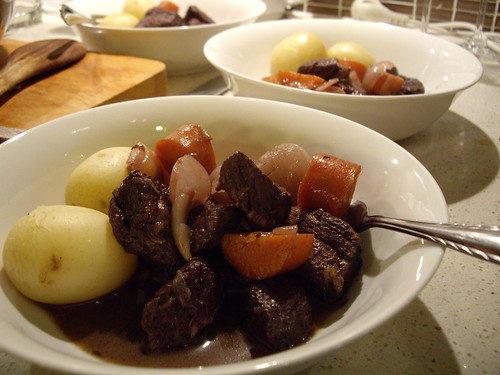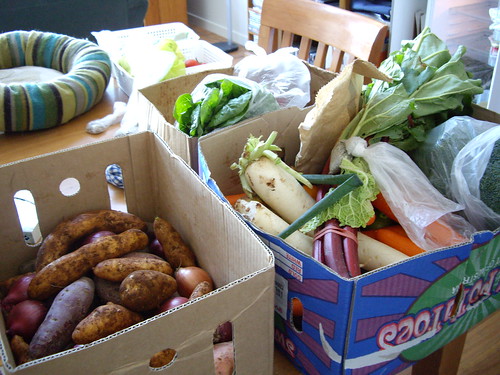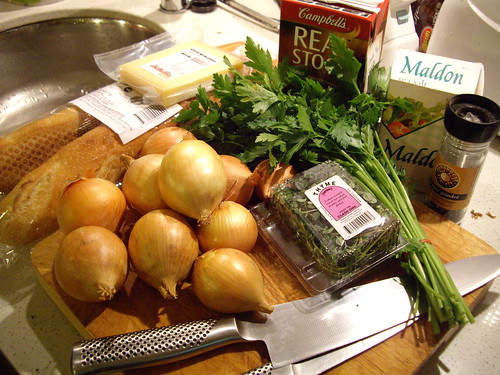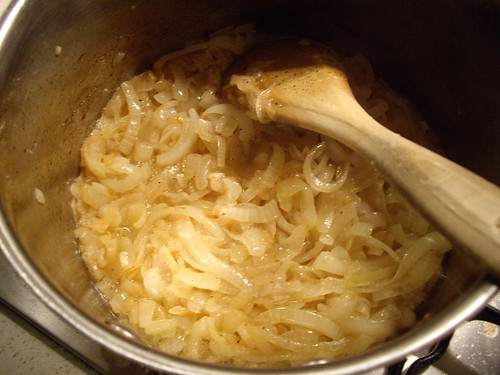Instead, I'm still recovering from the impacted bowel I always seem to get when I digest what passes for food in that forsaken land. There is good food in the USA, but you just happen to pay through the nose for it, and no matter what you pay, getting a good serve of vegetables, or bread without gallons for corn syrup, is nigh impossible.
Vancouver, which I also visited, is a foodie heaven, however. Awesome seafood, an understanding that vegetables are important, and a mighty fine understanding of how to make a martini.
But, long story short, I'm back. Now to try and get the hang of cooking for myself again after a week and a half of being waited on and making nothing more strenuous than black coffee.
So, let's drift back in time to a dinner party I hosted a little while ago, for a lesson in how far you can push a recipe and still make it work.
Beef in Red Wine, with boiled new potatoes
Normally I like to go through ingredients and do the whole nine yards recipe thing, but the truth is... I really consider this dish a pretty serious failure. So, basically, I'm not even going to suggest you cook it. But it's an interesting and illustrative failure, at least.
Beef bourguignon, which this is a bastardised version of, is a classic dinner party dish. Rich, hearty, and really easy to make ahead of time. In fact, many recipes call for just that - make it the night before, let the flavours intensify overnight, then reheat to the tasty amazement of your guests. The problem with that is simple - who has time to cook a meal that technically should be on the go for hours, put it aside for the next night, then make something so you can eat there and then? It's a time intensive dish, and like a lot of city dwellers, time's a serious commodity for me.
That said, there are some handy shortcuts, and I've made this dish before in about an hour, and it's super good. But when you're already shortcutting a recipe, the last thing you want to be doing is cutting any more corners, and that's where my last Beef and Red Wine really fell down.
The people I was cooking this for presented a range of interesting challenges, not the least of which was a serious dairy allergy. Another guest doesn't dig on pig (I know, it's crazy, but she's a lovely person), and I do believe there was even some gluten issues at hand.
The thing about cooking is that it's effectively science for your mouth. Any really good dish is a series of chemical and organic reactions, as well as complex interactions of mouth feel and flavour; messing about with any facet of a dish often has disastrous consequences. I know this. I knew it then, too, but I was so stuck with the idea of presenting a ballsy beef bourguignon, and cooking it in front of my guests (because, for me, cooking is as much about being seen to prepare good food as it is presenting that good food - it's a performance thing) that I just plowed ahead, and figured I could easily cook a dish that was already flaunting the recipe, and go ahead and remove butter, bacon, and flour.
Rookie. Fucking. Mistake.

Sure, it looks okay. But that's just what it wants you to think. Look closer, and the rich-seeming sauce is missing that all important shimmer of butter. That sauce is also being soaked up by the beef, because it's not been thickened by the flour.
And, when you taste it, it's lacking anything like the body it should have. Oh, bacon, why dids't I forsake thou?!
Because I'm an idiot, that's why!
The annoying thing is that this is dish I can really cook - and in just an hour or so. But it needs those important ingredients. The butter adds richness, a silky mouthfeel, and thickens the sauce. The flour should coat the meat when it's first browned, which transfers a magic amount to the pan, while also adding further thickness when the meat's added again later in the dish, not to mention changing the consistency of that meat. And the bacon - it's bacon! Rich, smoky bacon.
There's simply no stock rich enough, no demi glace ballsy enough (as Bourdain would put it), to make up for not having those important elements. What I produced was a flat, flavourless dish that if you got it in a restaurant, you'd send back to the kitchen with a sternly worded letter to the chef.
Of course, all this whining aside, the final irony is, well, kind of delicious. Everyone seemed to enjoy it, but one of my guests went back for seconds and thirds. He told me it was one of the tastiest things I'd ever cooked for him.
Then again, this is the guy who's allergic to dairy - what would he know*?!
* Actually, quite a lot, as he's a cook I quite respect in his own right. But nonetheless...





